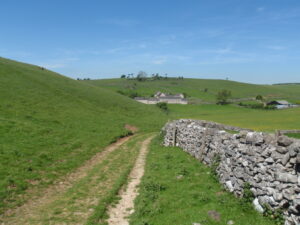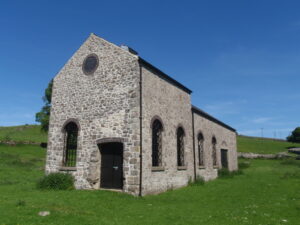ROYSTONE GRANGE settlement
 An Information board describes the site history –
An Information board describes the site history –
“For three hundred years during Roman times farmers ploughed, sowed and reaped their crops in this valley, living off the land in an organised, self-sufficient small community.
You are standing on the edge of a small native settlement first occupied about 1,800 years ago. The settlement, defined by a low wall of large limestone blocks, was built on the edge of a single large field which contained the hill now known as Roy stone Rocks, to your left The large field was probably used for winter pasture for sheep and cattle. Cereal and root crops were grown in another large field across the valley to the south-east.
Excavation of the terrace 10 metres up the slope has revealed a farmstead used from the second to the fourth centuries A.D. On this stone-fronted terrace, the first building had low, bow-shaped stone walls and a pitched roof of thatch, supported by two rows of four posts. This is a typical building of the second century A.D. in the Midlands and often preceded the development of grander villas. Finds from this site included fine Samian pottery imported from Caul (modern France) and luxury goods like brooches. The wealth of the farm at this time was probably derived from farming and lead mining.
The second building, dating to the fourth century A.D., was smaller and much less luxurious. A limestone-flagged floor was contained within walls made probably of turf. All the pottery found in this building was coarse, locally-made material. The indications are that this more modest building was the result of the general economic decline within the Empire as well as the exhaustion of the local, easily available lead ores.
This terrace is only one of a number of building platforms within the settlement. It is possible that in the early phase there was only a single farmstead which developed later in the Roman period into a more extensive, though poorer, village settlement.”
Just a little further on are the remains of Roystone Grange Hall and the 19th century pumphouse used during construction of the CHPR (Cromford and High Peak Railway)

Remains of Roystone Grange Hall
Roystone Grange on-site information board gives the following details –
Roystone Grange was a monastic sheep farm. From the 12th century to the 14th centuries flocks of sheep grazed the surrounding pastures, and their wool was exported to Europe, to Italy and beyond.
During the twelfth century, in the reign of King Hcnry II, Adam of Harthill gave “pasture., beasts-appurtenances in the vill of Revestones’ to the Cistercian Abbey of Carendon. Leicestershire: The Abbey established this grange farm here below the valley’s only permanent spring.
The low turf-covered walls up the slope to your right are all that now remain of the grange hall and one of the barns-that went with it. The ground floorof the grange was used for storage with living quarters above. Dealing with excess water seems to have been a major problem which the lay brethren running the grange solved by digging many, stone-lined drains around and beneath the grange.
Beside the grange was one of the barns. It seems to have been used chiefly as a dajry. The northern end was a byre and milking parlour, the central hearth was used for boiling milk and there was an oven in the southern end. The pottery from the site is that usually associated with milk products and production.
Garendon Abbey ceased farming the grange directly possibly in the late 14th century and it was leased to lay tenants. After the Dissolution of the Monastries in 1536 it was granted to Rowland Babington who built a new farm in the field to the north.
The chapel like building you are standing.beside is a 19th century building and was originally a pump house. A large water-cooled engine pumped compressed air through cast iron pipes to drive. the rock drills in the quarries that developed along the Cromford and High Peak Railway line, now the High Peak Trail.


